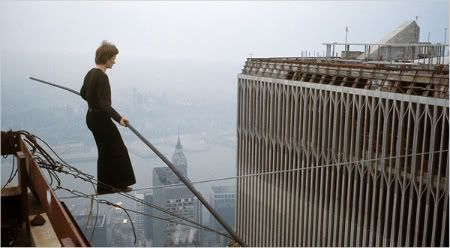Nothing is entirely by itself: each thing as strange as the last, and connected

[Photo by Jean-Louis Blondeau, NYT]
On August 7, 1974, after six years of careful planning, Philippe Petit strung a cable between the two towers of the World Trade Center and spent 45 early morning minutes walking, running, and dancing across. This event is the linchpin of Colum McCann's Let the Great World Spin; it is the point around which McCann's several different narratives rotate, and (to mix my metaphors) it is the bright, extraordinary moment that sheds its light on all the ordinary moments that make up the novel. Let the Great World Spin is a novel of connection and, like David Mitchell's Ghostwritten or Edwidge Danticat's The Dew Breaker, part of the purpose of the book is to expose the hidden relationships between events and characters that seem, at first, entirely unconnected. As the connections between different storylines and characters become clear, Philippe Petit's tightrope walk moves to the periphery and the stories begin to rotate around each other, bumping and jostling and creating more connections as they go.
But Let the Great World Spin is not only a novel of connection; it's also a September 11th novel. Since it's set in 1974, McCann writes less overtly about the 9/11 tragedy than other authors I've read (Pat Barker in Double Vision, Jonathan Safran Foer in Extremely Loud and Incredibly Close), but it's there nonetheless. No book that takes the Twin Towers as its central image can avoid the implication. McCann's approach to writing about 9/11 is interesting, and perhaps the most successful of any of the attempts I've read. His setting forces him to tell it slant, so he chooses instead to depict another disaster for New York: the homegrown disaster of life there in the 1970s. The most powerful part of the book is McCann's description of the South Bronx in the 1970s, an urban wasteland sprawling under the smoke of uncontrolled arson. Although a number of characters actually live in a housing project in the midst of this devastation, the grit seems realest when seen through the eyes of Solomon Soderburg, a judge who lives on Park Ave but in his courtroom comes into contact with every variety of human abasement on show in New York.
There's a lot of technical skill on display in Let the Great World Spin: McCann's prose style is usually quite good, and there are occasional sentences where it's great; he managed to make me believe in some of the most implausible links in this book of links between people and places; there were a few really lovely moments when we got to watch characters tiptoe gingerly out of the self and onto the tightrope of connection to another person. Yet for all that, the book never quite came to life for me. It took me a whole month to read, and I spent seemingly the whole month flip-flopping. I liked McCann's writing and then I didn't; I thought he had a lot to say and then I thought he had nothing to say; I liked the fact that every story arc lifted toward redemption and then I thought that was foolish and unrealistic. Endlessly back and forth. I've tried and tried to figure out why I was so ambivalent towards the book, but I haven't been able to hit on an answer. Was I resisting it? Was it just a case of wrong book at the wrong time? Or wrong book for wrong reader? I don't know. I don't think it's a bad book, and it is, of course, useful for me to read in light of my own book of interconnected storylines, but somehow it didn't sing for me.